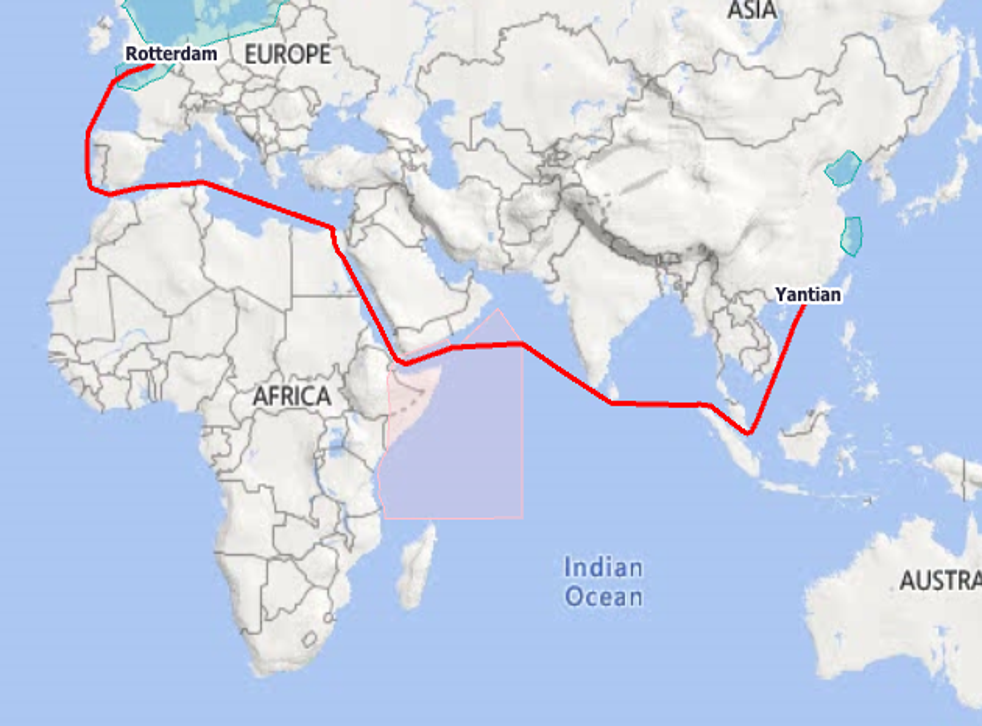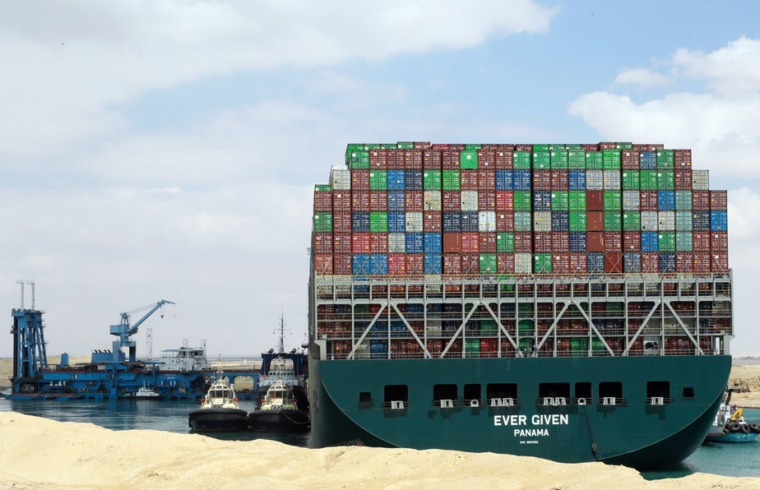Rescue efforts to free cargo ship blocking Suez Canal
A new attempt to re-float the MV Ever Given which is blocking Egypt’s Suez Canal has failed, according to its technical manager. More tugs are being brought in to help on Sunday, according to Bernhard Schulte Shipmanagement
It comes as other ships are beginning to reroute around the Cape of Good Hope instead of waiting at the canal.
The trip from Asia to Europe around the southern tip of Africa is longer, but operators may calculate their vessels will make better time on that route than waiting for the Ever Given to be refloated in Suez.
The backlog of ships caused by the container ship’s grounding in the Suez Canal has reached 248, according to experts from Lloyds List Intelligence.
The Ever Given, a Panama-flagged ship operated by Taiwan’s Evergreen and owned by Shoei Kisen KK, a Japanese company, became wedged sideways across the vital waterway on Tuesday.
Read more
How much longer is the shipping route via the Cape of Good Hope?
More vessels are diverting their course around the Cape of Good Hope to bypass the blockage through the Suez Canal.
According to data from Marine Benchmark, the route from Yantian – a deep water port in Shenzhen, Guangdong – to the port of Rotterdam – Europe’s largest sea port – would take an additional seven days at sea via the Cape of Good Hope for a vessel the size of the Ever Given container ship.
The route via the Cape of Good Hope is 13,165 nautical miles, compared to 9,904 nautical miles through the Suez Canal.

A shipping route from Yantian, China, to Rotterdam, the Netherlands, via the Suez Canal would take approximately 22 days
(Marine Benchmark)
A shipping route from Yantian, China, to Rotterdam, the Netherlands, via the Cape of Good Hope would take approximately 29 days
(Marine Benchmark)
Huge vessels like these usually move at a variable speed limit of around 19.5 to 20 knots, faster than smaller cargo ships and tankers, which move at around 15 to 16 knots, according to Kunal Anand, head of maritime professional courses, Warsash Maritime School.
But although the decision to skip the Suez Canal blockage in favour of the Cape of Good Hope might seem obvious for us non-mariners, Mr Anand said captains and crews must take into consideration a number of risky factors.
Firstly it depends on where the ships are. Ships that are currently in the Malacca Straits may be able trying to decide what to do as they know the Canal is currently blocked.
“There might be ships between the Malacca Straits and the Red Sea who may have to decide at one point what course they want to take,” said Mr Anand. “if they decide coming out of the Malacca Straits not to use the Suez, they would have to do an additional 3,200 nautical miles straight down to the bottom of Africa and back up again to Rotterdam.”
The type of ship they are commandeering will also affect the decisions made – particularly because the Cape of Good Hope is often plagued by bad weather, he added.
“In the Cape of Good Hope, the weather is very rough throughout the year, very bad weather. Smaller and slower ships will find it very tough so whether they want to take that risk is another consideration. For bigger ships, there is also problem of losing cargo and damage to the ship from the rough seas.”
There is also the question of whether ships have enough fuel and provisions. A journey of an extra seven days – which could extend to nine days for slower ships – could mean hundreds of thousands of pounds in fuel costs.
He said the blockage in the Suez Canal could take anywhere between another five to seven days to clear. The backlog of ships waiting to pass through the Canal would also add to delays, even if capacity was increased to a maximum of 70 ships a day instead of 50.
“Even if they were to ramp up the Canal to maximum capacity, depending on how long the blockage lasts, there would be delays to ships currently waiting,” said Mr Anand.
Kate Ng26 March 2021 17:10
US Navy to send team of experts to Suez Canal
The US Navy is expected to send an assessment team of dredging experts to the Suez Canal by Saturday to advise Egyptian authorities on dislodging the Ever Given ship, it has been reported.
According to CNN journalist Barbara Starr, the information was provided by two officials from the Department of Defence.
Kate Ng26 March 2021 16:26
Satellite captures growing number of ships waiting for Suez Canal to clear
Kate Ng26 March 2021 16:00
Over 100 ships en route to Suez Canal, according to estimates
Data from Refinitiv estimates there are more than 100 ships in transit to the Suez Canal, which is still blocked.
Ranjith Raja, head of MENA oil and shipping research at Refinitiv, comments: “As of this morning until the end of March, there are at least 137 ships that are expected to be reaching either side of the Suez for the canal transit.
“This is in addition to the ships (around 200) that have already reached and have been waiting since yesterday. As more ships update their tracking (AIS) destination and ETA, further updates will become available.
“Despite ongoing efforts to unblock the channel, we’re looking at the mother of all traffic jams shipping-wise over the next week or so. It’s inevitable that we’ll see vessels choosing to divert via the southern tip of Africa adding to costs in terms of time and fuel.
“This also includes having to contend with the Piracy Zone, off the coast of Somalia, where ships need to factor in a security risk assessment to pass through or take the longer route around.”
Kate Ng26 March 2021 15:31
Suez Canal: Everything we know about the grounded Ever Given ship
The massive container ship blocking one of the world’s most important shipping routes remains aground two days after it first became wedged midway along the Suez Canal.
Tugboat teams and heavy machines are still battling to nudge the MV Ever Given free as more than 250 ships queue to get past and the ship’s owner apologises for the inevitable knock-on effect on global supply chains.
Jon Sharman26 March 2021 15:09
The scene as tugs and dredger try to free Ever Given
(AFP via Getty Images)
Jon Sharman26 March 2021 15:04
Re-flotation attempt fails
Another attempt to re-float the Ever Given has failed, according to the ship’s technical manager.
Extra tugs are being drafted in and water will be pumped out of the ship.
Bernhard Schulte Shipmanagement said in a statement on Friday afternoon: “The focus is now on dredging to remove sand and mud from around the port side of the vessel’s bow.
“A specialised suction dredger, which can shift 2,000 cubic metres of material every hour, arrived on site on 25 March.
“Arrangements are also being made for high-capacity pumps to reduce the water levels in the forward void space of the vessel and the bow thruster room.
“Another attempt to re-float the vessel earlier today, 26 March, was not successful.
“Smit Salvage’s team on board confirm there will be two additional tugs … arriving by 28 March.”
Jon Sharman26 March 2021 14:45
New pictures show dredger trying to free Ever Given
New images released by the Suez Canal Authority show more details of the operation to re-float the MV Ever Given.
The blue craft is the naval dredger Mashhour.
The Suez Canal Authority said in a statement today that it welcomed international offers to help free the vessel, including one from the United States, although it did not say what kind of assistance was offered.
The dredging operation underway
(AFP via Getty Images)
Egyptian tugboats try to pull out the Ever Given container ship
(EPA)
Jon Sharman26 March 2021 14:26
Suez blockage ‘could cost world $10bn a week’
The blockage of the Suez Canal by the MV Ever Given could cost the world economy $10bn (£7.25bn) a week, according to a top insurer.
A study by Europe’s biggest insurer Allianz also found that each week of gridlock chips about 0.2 to 0.4 percentage points off annual trade growth.
“The problem is that the Suez Canal blockage is the straw that breaks global trade’s back,” the study’s authors wrote.
“First, suppliers’ delivery times have lengthened since the start of the year and are now longer in Europe than during the peak of the CovidD-19 pandemic.”
Second, the study said that the length of delivery times in the US was twice as bad, because inventories were depleted on expectations that Joe Biden’s huge stimulus package would boost demand.
Jon Sharman26 March 2021 14:07
World could be forced to re-think use of ultra-large ships, lecturer suggests
The global shipping industry may have to re-evaluate the use of ultra-large container ships (UCLS) in the wake of the Ever Given incident, according to UK lecturer.
Nicola Pryce-Roberts, a senior lecturer in maritime business and law at Warsash Maritime School, said that “questions will no doubt be asked about the safety” of those vessels.
She wrote on the school’s website: “Although bigger and more unwieldly to navigate, in theory, they are no more risky than smaller vessels. A vessel half the length of the Ever Given may just as easily have blocked the Suez Canal.”
She added: “If, however, it is discovered that the sheer size of the Ever Given and her container stacks were a contributing factor to the casualty we may be forced to reconsider the theory.
“ULCS usually trade in the background of our lives carrying the goods we each use every day. It is the size and number of containers carried onboard, in excess of 20,000 20ft containers, which makes an ULCS economically attractive to their owners and any salvage operation involving an ULCS challenging.
“When an incident occurs at sea involving an ULCS specialist floating cranes may be needed to remove containers, and consideration given to where those containers will be stored.
“These vessels are 400m in length, so when they run aground in narrow channels or rivers they can, as we see with the Ever Given, be a substantial obstacle to navigation.
“It is important then that we maintain a sustainable salvage capability to deal with any future ULCS incidents. We do so by financially encouraging those salvage companies who offer these vital services when we need them.
“We all have a stake in this; we all benefit from the economies of scale ULCS bring in keeping the cost of moving goods around the globe low.”
Jon Sharman26 March 2021 13:44









